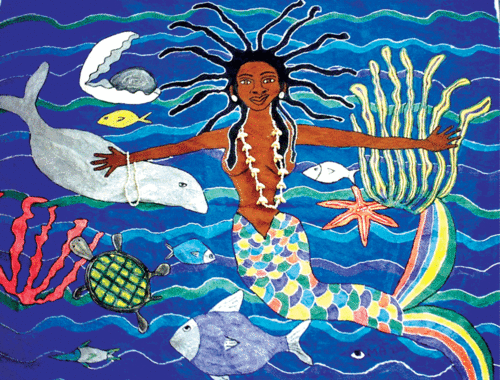Mami Wata
Mami Wata is a female figure important to religious and social life in many parts of Africa. In some cultures she is a goddess. In others, the term Mami Wata refers to women who have the qualities of Mami Wata, including exceptional beauty and great power. Throughout western and central Africa, Mami Wata is a beautiful river goddess with long flowing hair and fair skin. During colonial times, prints from Europe or India of light-skinned women and female deities were often used to represent Mami Wata. In other images, she is shown with the tail of a fish to indicate her connection with the world of water spirits.
Mami Wata is believed to be powerful and seductive. She may bring good fortune to those who worship her, but she may cause terrible misfortune to those who anger her. Her wild, free, and independent nature is associated with the modern lifestyle of urban women. She also represents irresistible female sexuality.

The worship of Mami Wata as a deity appears to have arisen in the early 1900s in southern NIGERIA and then spread to other parts of Africa. Men and women join the cult of Mami Wata for a variety of reasons, including physical and spiritual sickness. To please her, they make offerings of sweet drinks and food, perfume, powder, and other luxury goods used by women.
In CONGO (KINSHASA), Mami Wata is represented as a mermaid in the west and as a crocodile person, known also as Mamba Muntu, in the east. Images of Mami Wata are found in murals, paintings, and other forms of popular ART. The idea of a being that is half woman, half aquatic animal combines elements of local culture, including traditional beliefs in water sprits, a colonial-era belief that whites were ghosts who came from beyond the sea, and aspects of West African folklore. As African nations gained independence from their European rulers in the mid-1900s, Mami Wata became an important social and political symbol in the Congo region. Many people displayed a painting of Mami Wata in their homes because she was said to provide guidance on how to succeed in the modern world. However, such paintings often showed her accompanied by a snake, which represented evil. The snake reminded the viewer that the knowledge, power, and wealth offered by Mami Wata and modern urban life could be harmful if misused. After the 1980s, Christian symbols and paintings took the place of most Mami Wata images in city homes. (See also Gender Roles and Sexuality, Popular Culture, Religion and Ritual, Women in Africa.)